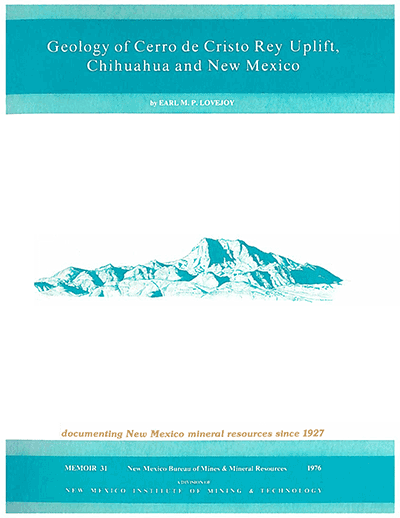
Memoir 31—Geology of Cerro de Cristo Rey uplift, chihuahua and New Mexico
By E. M. P. Lovejoy, 1976, 84 pp., 12 tables, 55 figs., 2 appendices, 6 sheets in pocket, 1 index.

This uplift is a well-exposed hypabyssal plutonic complex located near the intersection of the Rio Grande trench and the Texas lineament. Stresses the stratigraphy and development of the structure of the uplift. Includes an article by W. S. Strain, New Formation names in the Cretaceous at Cristo Rey.
The Cerro de Cristo Rey uplift is about 3,000 m in diameter. It stands astride the US-Mexico boundary 8 km west of El Paso, Texas and is bounded on the east and north by the Rio Grande. An andesite central pluton and a felsite partial-ring confocal pluton about 45-49 million years old have intruded and deformed about 300 m of Cretaceous marine strata. Deep erosion of the order of hundreds of meters around the uplift has exposed the pluton; evidence is excellent for two major subsidences about 2,500 m and 2,250 m in diameter. The pluton formed after tectonism ceased in the Dierra de Juarez of the Chihuahua tectonic belt, perhaps early during the tectonism that produced the Basin and Range province.
North-trending prepluton folds have been arched up by the intrusion. Trapdoor faulting and major ascent of magma on the west side of the pluton gave rise to gravity gliding of roof strata on the north and northeast, resulting in accentuation of preintrusion folds that now strike around the east side of the pluton. Sundering of a large block into the magma chamber also produced cascade folds from the roof on the east side. Several episodes of expansion and contraction are evident. Although the pluton is situated on the Texas lineament, evidence is lacking for any activity along the Texas lineament.
Cerro de Cristo Rey is the name given a prominent peak which lies on the international border between Mexico and the United States, in the states of New Mexico and Chihuahua. The mountain, earlier named and still called by some the Cerro de Muleros, and locally called by others the Cerros de la Cruz because of the large statue of Christ on the cross at its crest, has an elevation of 1,425 m. This is almost 300 m above the valley of the Rio Grande, Mesilla Valley. Because the Cerro is surrounded by more prominent ranges such as the Franklin Mountains and the Sierra del Paso del Norte, or the Sierra de Juarez west of Juarez, Chihuahua, it is not an eminence worthy of much note to the casual observer or tourist.
The principal purposes of this study were: (1) the determination of the surficial geometry of rock around the Cristo Rey pluton; (2) an attempt to decipher the 3-D geometry of the pluton; (3) a study of the kinematics or movements of those rocks; and (4) an analysis of the kinetics or forces which produced those movements.
$14.75
Buy
Now
Also available as a free download.
Download
| File Name | Size | Last Modified |
|---|---|---|
| Memoir-31.pdf | 37.18 MB | 01/19/2021 09:29:36 AM |



